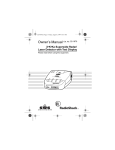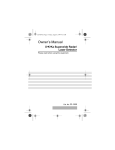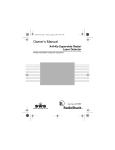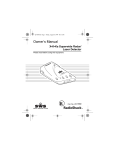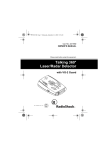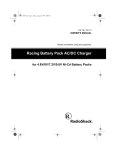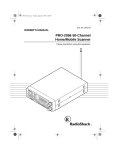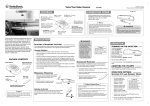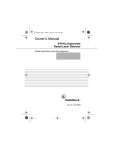Download Radio Shack XoKoKa Superwide Owner`s manual
Transcript
22-1676.fm Page 1 Friday, August 6, 1999 10:38 AM Owner’s Manual Front/Rear Laser X•K•Ka Superwide Radar Detector with VG-2 Guard Please read before using this equipment. Cat. No. 22-1676 22-1676.fm Page 2 Friday, August 6, 1999 10:38 AM FEATURES Your RadioShack Front/Rear Laser X•K•Ka Superwide Radar Detector receives all X-, K-, and Ka-band traffic radar signals and also detects both the instant-on and laser systems many police departments now use to measure vehicle speed. Plus, it can alert you to road hazards signaled by either a Safety Warning System or Safety Alert Signal. When it detects a signal, your easyto-mount detector alerts you with a light and a tone, which increase in speed as the signal gets stronger. The detector’s built-in laser sensors detect traffic laser signals coming from in front of and behind your vehicle. Your detector also has FAST® (False Alert Suppression Technology) circuitry that helps prevent false alarms caused by signals from other radar detectors, without reducing your detector’s sensitivity to traffic radar signals. Your detector’s many useful features include: VG-2 Protection — makes your detector invisible to the VG-2 radar-detector detector when its senses VG-2 is being used. 1997 Tandy Corporation. All Rights Reserved. RadioShack is a registered trademark used by Tandy Corporation. Safety Alert is a trademark of Cobra Electronics. FAST is a registered trademark used by Tandy Corporation. InstaClear is a registered trademark used by Ford Motor Company. ElectriClear is a registered trademark used by Libbey, Owens, Ford, and Delco-Remy. 2 22-1676.fm Page 3 Friday, August 6, 1999 10:38 AM Safety Alert Signal Detection — warns you when the detector detects signals broadcast by safety alert transmitters. Some public safety and government agencies install these transmitters in some emergency vehicles and near some known road hazards and construction areas, to provide advance warning of potentially hazardous situations. Safety Warning System — alerts you to the presence of potential road hazards and emergency vehicles signalled by a safety radar transmission. X-, K-, Ka-Band, and Laser Signal Detection — warns you when the detector detects signals from traffic radar or laser devices. Different tones sound and different indicators flash to let you know the type of signal received. City/Highway Modes — let you reduce the detector’s sensitivity to weak X-, K-, and Ka-band signals, without affecting the detector’s sensitivity to laser signals while you are in the city. Note: Some areas have laws regulating the use of radar detectors. Check with your local law enforcement agency about the laws in your area. 3 22-1676.fm Page 4 Friday, August 6, 1999 10:38 AM We recommend you record your detector’s serial number here. The number is on the detector’s bottom panel. Serial Number:_______________________________ 4 22-1676.fm Page 5 Friday, August 6, 1999 10:38 AM Your detector includes the following items: • Hook-and-loop tape • Bracket holder • Sun visor clip • Windshield bracket and holder • Power cord • Power cord clips (6) 5 22-1676.fm Page 6 Friday, August 6, 1999 10:38 AM CONTENTS A Look at the Detector ............................................ 7 Safety Alert and Safety Warning System ............ 10 Installation .............................................................. 11 Selecting a Mounting Location ...........................11 Hook-and-Loop Mounting .................................. 12 Visor Mounting .................................................. 13 Removing the Sun Visor Clip ...................... 15 Windshield Mounting ........................................ 16 Connecting Power ............................................ 17 Mounting the Power Cord Clips .................. 19 Operation ............................................................... Turning the Detector On and Off ...................... Adjusting the Volume ........................................ Operating Settings ............................................ Selecting the City and Highway Modes ....... Muting the Audio Alert ................................. Turning Off the Display ................................ Receiving and Identifying Radar, Laser, Safety Alert, Safety Warning System, and VG-2 Signals ............................................. 20 20 20 21 21 22 23 23 Troubleshooting .................................................... 25 Care and Maintenance .......................................... 28 Replacing the Fuse ........................................... 29 6 22-1676.fm Page 7 Friday, August 6, 1999 10:38 AM A LOOK AT THE DETECTOR Front Laser Detection Lenses — receive incoming laser signals directed at the front of your vehicle. DC 12V Jack — the power cord plugs in here. DARK Button — turns off all your detector’s indicators, except the P (Power) indicator. 7 22-1676.fm Page 8 Friday, August 6, 1999 10:38 AM MUTE Button — silences the alert sound. CITY (City/Highway) Button — switches between the city and highway modes. Signal Strength Indicator — two LEDs show an accurate visual indication of the strength of the radar signals received. S (Stationary Road Hazard Situation) Indicator — blinks when the detector detects the signal related to a stationary road hazard, either from the safety warning system or from a safety alert transmitter. M (Emergency/Slow Moving Vehicles) Indicator — blinks when the detector detects the signal related to emergency/slow moving vehicles, either from the safety warning system or from a safety alert transmitter. O (Rail Road) Indicator — both LEDs under S and M blink at the same time when the detector detects the signal related to a railroad, either from the safety warning system or from a safety alert transmitter. C/SA (City/Safety Alert) Indicator — lights when the detector is in the city mode and blinks when the detector detects a safety alert signal. K/Ka (K- and Ka-Band Radar) Indicator — blinks when the detector detects either a K- or Ka-band radar signal. 8 22-1676.fm Page 9 Friday, August 6, 1999 10:38 AM X (X-Band Radar) Indicator — blinks when the detector detects an X-band radar signal. L (Laser) Indicator — both LEDs under X and K/Ka light when the detector detects a traffic laser signal. VG-2 Indicator — lights when a VG-2 signal is detected. P (Power) Indicator — lights when you connect the detector to power and turn it on. LASER (Rear Laser Detection Lens) — receives laser signals directed at the rear of your vehicle. VOLUME/OFF Control — turns the detector on and off and lets you adjust the volume. 9 22-1676.fm Page 10 Friday, August 6, 1999 10:38 AM SAFETY ALERT AND SAFETY WARNING SYSTEM These systems are low-powered transmitters used by some emergency services and road crews to alert drivers to hazardous conditions. The Safety Alert system can indicate stationary, moving, or railroad hazards. Radar detectors that are Safety Alert compatible, such as this one, indicate the presence of a Safety Alert signal. The Safety Warning System is like Safety Alert, but it operates at a higher power level and can alert you to many different emergency or hazardous conditions in the area. Your detector’s three safety indications show three major categories of Safety Warning System messages. While neither system is currently in wide use, they have the potential to dramatically decrease the potential for traffic accidents by increasing drivers’ awareness of local road hazards. Having this radar/laser detector will ensure that you are ready to use these systems as they come into use. 10 22-1676.fm Page 11 Friday, August 6, 1999 10:38 AM INSTALLATION SELECTING A MOUNTING LOCATION For the best performance, select a location for the detector where it has a direct view of the road. The detector’s radar antenna and front laser detection lenses are at the opposite end from the rear laser detection lens and controls. Follow these guidelines when you select a mounting location. • Choose a location that does not block the driver’s view of the road. • Mount the detector in a level position with a clear view to both the front and rear. • Since signals are blocked by metal surfaces, the detector’s view of the road must not be blocked. 11 22-1676.fm Page 12 Friday, August 6, 1999 10:38 AM • Some vehicles have InstaClear® or ElectriClear® defogging windshields, which have metal coatings that block signals. General Motors APV vans have a solar shield that keeps the vehicle cooler during the summer. This shield also blocks signals. A detector installed in a vehicle with any of these features will probably not detect a signal. • Since window tinting reduces the received strength of laser signals, you should not mount the detector behind any tinted glass. Do not mount the detector where the driver or a passenger might hit it in a sudden stop or accident. • Caution: Whichever mounting method you choose, place the detector out of view when you leave the vehicle. This keeps the detector out of sight of thieves and prevents exposing it to extremely high temperatures, which can temporarily impair your detector’s performance. HOOK-AND-LOOP MOUNTING For some dashboards, the hook-and-loop tape supplied with your detector might be best for mounting. Follow these steps to use the hook-and-loop tape. 1. Use a damp cloth to thoroughly clean both the bottom of the detector and the dashboard. Let both surfaces dry completely. 12 22-1676.fm Page 13 Friday, August 6, 1999 10:38 AM Note: The tape’s adhesive might not stick to a surface treated with vinyl cleaner or protectant. 2. Peel off the paper backing on one side of both pieces of tape, then apply both pieces of tape to the bottom of your detector. Notes: • If you are mounting the detector on a curved dashboard, you might need to cut the hook-and-loop tape in half and use one strip in each corner of the bottom of the detector. • Do not place the hook-and-loop tape over the detector’s serial number. 3. Remove the paper backing from the other side of the tape and press your detector onto the dashboard. VISOR MOUNTING The supplied sun visor clip and bracket holder let you quickly mount the detector on your vehicle’s sun visor. 13 22-1676.fm Page 14 Friday, August 6, 1999 10:38 AM Warning: Do not mount the detector on a visor if this places the detector near the driver’s or a passenger’s head. Follow these steps to use the sun visor clip. 1. Slide the sun visor clip into the bracket holder’s slot. Note: For proper mounting, you must attach the bracket holder as shown. Do not reverse it. 2. Snap the bracket holder onto the top of the detector. Make sure the mounting tabs inside the bracket holder fit into the mounting slots on the sides of the detector. 14 22-1676.fm Page 15 Friday, August 6, 1999 10:38 AM 3. Clip the detector to the edge of the sun visor so you can see the detector’s front display. Removing the Sun Visor Clip If you later want to use another method for mounting the detector, follow these steps to remove the sun visor clip from the bracket holder. 1. Pull up on one side of the bracket holder to remove it from the detector. 15 22-1676.fm Page 16 Friday, August 6, 1999 10:38 AM 2. Using a flathead screwdriver, carefully lift out the plastic tongue holding the sun visor clip and bracket holder together, then slide the sun visor clip out of the bracket holder. WINDSHIELD MOUNTING The supplied windshield bracket and holder let you quickly mount the detector on your vehicle’s windshield. Note: Some vehicles have a soft plastic coating on the inside surface of the windshield. The windshield bracket’s suction cups can cause permanent marking on this kind of windshield. 1. Slide the windshield bracket assembly into the bracket holder along the groove on the bracket holder. 2. Snap the bracket holder into the radar detector’s track. 16 22-1676.fm Page 17 Friday, August 6, 1999 10:38 AM 3. Clean the windshield where the detector will be mounted. 4. Position the bracket on the windshield and press firmly on each suction cup. 5. If necessary, you can adjust the angle by removing the detector and bending the windshield bracket. Caution: Bending the bracket with the detector installed may damage the bracket. To remove the windshield bracket from the bracket holder, first detach the bracket holder from the detector, then pull up the small locking bar at the center of the bracket and pull the bracket out of the slot. CONNECTING POWER Plug the supplied power cord’s barrel plug into the DC 12V jack on the side of the detector. Make sure the knurled ring on the tip of the plug is firmly screwed in, then plug the power cord’s cigarette-lighter plug into your vehicle’s cigarette-lighter socket. 17 22-1676.fm Page 18 Friday, August 6, 1999 10:38 AM Caution: Unplug the power cord from your vehicle’s cigarette-lighter socket when you turn off the ignition. This prevents your vehicle’s battery from being drained if you leave the detector on when you turn off the ignition. Note: If the detector does not operate when you turn it on, unplug the power cord from your vehicle’s cigarettelighter socket and carefully check the socket for ashes and other debris. Also, check the fuse in the power cord and your vehicle’s fuse block (see “Replacing the Fuse” on Page 29). 18 22-1676.fm Page 19 Friday, August 6, 1999 10:38 AM Mounting the Power Cord Clips You can use the supplied power cord clips to route the power cord out of the way. Follow these steps to mount the power cord clips. 1. Use a damp cloth to thoroughly clean the locations on the dashboard where you want to mount the clips. Let the dashboard dry completely. Note: The clip’s adhesive might not stick to a surface treated with vinyl cleaner or protectant. 2. Peel off each clip’s paper backing, then press the clip onto the selected mounting location. 19 22-1676.fm Page 20 Friday, August 6, 1999 10:38 AM OPERATION TURNING THE DETECTOR ON AND OFF To turn on the detector, turn VOLUME/OFF away from you until it clicks. The detector sounds a distinctive tone for each band and lights all indicators in sequence as a self test (X, K, Ka, L, M, S, O, and VG-2, in order). Then all indicators turn off, except the P indicator. To turn off the detector, turn VOLUME/OFF toward you until it clicks and all indicators turn off. ADJUSTING THE VOLUME Turn VOLUME/OFF away from you to increase the detector’s volume. Turn VOLUME/OFF toward you to reduce it. 20 22-1676.fm Page 21 Friday, August 6, 1999 10:38 AM OPERATING SETTINGS Selecting the City and Highway Modes Your detector has two operating modes: city and highway. In the city mode, the detector requires a stronger X-, K-, or Ka-band signal before it sounds or displays an alert. This eliminates responses to most false sources, such as automatic door openers and alarm systems. Note: The city mode has no effect on laser alerts or instant-on radar. The highway mode provides maximum sensitivity for open-road driving. To select the city mode, press CITY until the detector beeps once and the C indicator turns on. Note: If you set the detector to the city mode then turn off the display by pressing DARK, the detector might not give an audio or visual alarm while receiving a weak radar signal. 21 22-1676.fm Page 22 Friday, August 6, 1999 10:38 AM To select the highway mode, press CITY until the C indicator turns off. Muting the Audio Alert While the detector is sounding a radar or safety alert signal, you can press MUTE to temporarily silence the detector. The detector automatically resets to normal operation about 20 seconds after the radar or safety alert signal stops. Or, you can simply press MUTE again before it resets to return the detector to normal operation. Note: The laser alert signal remains active even if you press MUTE. 22 22-1676.fm Page 23 Friday, August 6, 1999 10:38 AM Turning Off the Display You can press DARK to temporarily turn off all indicators, except the L and P indicators. The L indicator alerts you to laser signals, the P indicator remains on to let you know the detector is receiving power, and the detector’s audio alert remains active. To return to the normal full indications, press DARK again. RECEIVING AND IDENTIFYING RADAR, LASER, SAFETY ALERT, SAFETY WARNING SYSTEM, AND VG-2 SIGNALS When your detector senses a radar, laser, or safety alert signal, it responds with both audible and visual alarms. The detector uses different audio and visual alarms to indicate the signal type, and indicates the signal strength by increasing the rate at which it flashes the indicator and sounds the tone. In addition, the 2 and 3 signal strength indicators light to visually indicate the strength of radar signals. 23 22-1676.fm Page 24 Friday, August 6, 1999 10:38 AM When your detector senses a radar signal, it responds with different audible and visual alarms to indicate the signal type for X- and K- or Ka-band radar signals. When your detector senses instant-on radar, it sounds continuous beeps, then all indicators light. When your detector senses a traffic laser, both the X- and K/Ka indicators flash, and the detector sounds continuous tones for 3 seconds. When your detector senses an alert signal from either a Safety Warning System or Safety Alert transmitter, it responds with distinctive audible and visual alarms to indicate a stationary road hazard (S), emergency/slow moving vehicles (M), or a train in transit (O). When your detector senses a VG-2 signal, it sounds a distinctive tone and the VG-2 indicator lights. Your detector checks every 30 seconds for a VG-2 signal. It does not respond to any radar source during a VG-2 alert, but laser alerts are not affected. 24 22-1676.fm Page 25 Friday, August 6, 1999 10:38 AM TROUBLESHOOTING If you have problems operating your detector, the suggestions in this section might help. If you cannot solve the problem after trying these suggestions, take your detector to your local RadioShack store for assistance. If the detector does not turn on: • Be sure all power connections are secure. • Check the fuse that controls power to your vehicle’s cigarette-lighter socket. See your vehicle’s owner’s manual. • Check the fuse in the power cord’s cigarette-lighter plug. See “Replacing the Fuse” on Page 29. • The cigarette-lighter socket might be dirty. Clean it with fine emery cloth to ensure a good, clean connection. Caution: Do not place any metal object other than the cigarette lighter or a cigarette-lighter plug in the cigarette-lighter socket. Doing so could blow a fuse in your vehicle or cause the metal object to become very hot. 25 22-1676.fm Page 26 Friday, August 6, 1999 10:38 AM If the detector gives a false alert when you use vehicle accessories such as power windows, motorized mirrors, brakes, and so on: • Check the vehicle’s electrical system for loose connections, including the main battery cable and alternator connections. • Install a filter capacitor (470 µf, 35 volts, such as Cat. No. 272-1030) on the back of the cigarettelighter socket, across the power connections. If the detector performs the self-test, but does not respond to radar signals when you see a police car: • A police car might not be equipped with radar, or might be using instant-on radar and not have the radar gun triggered (see the separate booklet Questions and Answers About Vehicle Speed Detection ). • Police might be using VASCAR-type speed detection (see the separate booklet Questions and Answers About Vehicle Speed Detection). If the detector has poor laser detection range: • Be sure the front and rear laser detection lenses are not blocked. • Be sure the detector is properly mounted. See “Selecting a Mounting Location” on Page 11. • Use lens-cleaning solution to clean the front and rear laser detection lenses. 26 22-1676.fm Page 27 Friday, August 6, 1999 10:38 AM CARE AND MAINTENANCE Your RadioShack Front/Rear Laser X•K•Ka Superwide Radar Detector is an example of superior design and craftsmanship. The following suggestions will help you care for the detector so you can enjoy it for years. Keep the detector dry. If it gets wet, wipe it dry immediately. Liquids can contain minerals that can corrode the electronic circuits. Handle the detector gently and carefully. Dropping it can damage circuit boards and cases, and can cause the detector to work improperly. Keep the detector away from dust and dirt, which can cause premature wear of parts. Wipe the detector with a damp cloth occasionally to keep it looking new. Do not use harsh chemicals, cleaning solvents, or strong detergents to clean it. 27 22-1676.fm Page 28 Friday, August 6, 1999 10:38 AM Modifying or tampering with the detector’s internal components can cause a malfunction and might invalidate its warranty. If your detector is not operating as it should, take it to your local RadioShack store for assistance. REPLACING THE FUSE If the detector stops operating, follow these steps to check the fuse in the power cord’s cigarette-lighter plug and replace the fuse, if necessary. 1. Carefully turn the knurled ring on the cigarettelighter plug counterclockwise to unscrew it. Caution: If you must use pliers to loosen the ring, be careful not to crush the ring or the metal tip inside the ring. 2. Carefully remove the ring and tip from the cigarettelighter plug, then remove the old fuse. Note: Take care not to lose the ring or tip, or the spring inside the plug. 28 22-1676.fm Page 29 Friday, August 6, 1999 10:38 AM 3. Check the fuse. If it has blown, replace it with a 2amp, 11/4 × 1/4, fast-acting fuse (Cat. No. 270-1007). Caution: Using a fuse that does not meet these ratings or defeating the fuse protection can damage your detector, the power cord, or the vehicle’s electrical system. 4. Replace the metal tip inside the ring, make sure the spring is in place, then place the fuse inside the cigarette-lighter plug and firmly screw the ring back onto the plug. Caution: Never use pliers or other tools to retighten the ring on the cigarette-lighter plug. 29 22-1676.fm Page 30 Friday, August 6, 1999 10:38 AM NOTES 30 22-1676.fm Page 31 Friday, August 6, 1999 10:38 AM 31 22-1676.fm Page 32 Friday, August 6, 1999 10:38 AM Limited One-Year Warranty This product is warranted by RadioShack against manufacturing defects in material and workmanship under normal use for one (1) year from the date of purchase from RadioShack company-owned stores and authorized RadioShack franchisees and dealers. EXCEPT AS PROVIDED HEREIN, RadioShack MAKES NO EXPRESS WARRANTIES AND ANY IMPLIED WARRANTIES, INCLUDING THOSE OF MERCHANTABILITY AND FITNESS FOR A PARTICULAR PURPOSE, ARE LIMITED IN DURATION TO THE DURATION OF THE WRITTEN LIMITED WARRANTIES CONTAINED HEREIN. EXCEPT AS PROVIDED HEREIN, RadioShack SHALL HAVE NO LIABILITY OR RESPONSIBILITY TO CUSTOMER OR ANY OTHER PERSON OR ENTITY WITH RESPECT TO ANY LIABILITY, LOSS OR DAMAGE CAUSED DIRECTLY OR INDIRECTLY BY USE OR PERFORMANCE OF THE PRODUCT OR ARISING OUT OF ANY BREACH OF THIS WARRANTY, INCLUDING, BUT NOT LIMITED TO, ANY DAMAGES RESULTING FROM INCONVENIENCE, LOSS OF TIME, DATA, PROPERTY, REVENUE, OR PROFIT OR ANY INDIRECT, SPECIAL, INCIDENTAL, OR CONSEQUENTIAL DAMAGES, EVEN IF RadioShack HAS BEEN ADVISED OF THE POSSIBILITY OF SUCH DAMAGES. Some states do not allow the limitations on how long an implied warranty lasts or the exclusion of incidental or consequential damages, so the above limitations or exclusions may not apply to you. In the event of a product defect during the warranty period, take the product and the RadioShack sales receipt as proof of purchase date to any RadioShack store. RadioShack will, at its option, unless otherwise provided by law: (a) correct the defect by product repair without charge for parts and labor; (b) replace the product with one of the same or similar design; or (c) refund the purchase price. All replaced parts and products, and products on which a refund is made, become the property of RadioShack. New or reconditioned parts and products may be used in the performance of warranty service. Repaired or replaced parts and products are warranted for the remainder of the original warranty period. You will be charged for repair or replacement of the product made after the expiration of the warranty period. This warranty does not cover: (a) damage or failure caused by or attributable to acts of God, abuse, accident, misuse, improper or abnormal usage, failure to follow instructions, improper installation or maintenance, alteration, lightning or other incidence of excess voltage or current; (b) any repairs other than those provided by a RadioShack Authorized Service Facility; (c) consumables such as fuses or batteries; (d) cosmetic damage; (e) transportation, shipping or insurance costs; or (f) costs of product removal, installation, set-up service adjustment or reinstallation. This warranty gives you specific legal rights, and you may also have other rights which vary from state to state. RadioShack Customer Relations, Dept. W, 100 Throckmorton St., Suite 600, Fort Worth, TX 76102 We Service What We Sell 3/97 RadioShack A Division of Tandy Corporation Fort Worth, Texas 76102 5A6 Printed in Korea
































